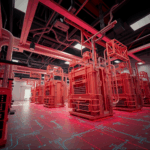
What are BIM Levels of Development (LOD) and How Do They Influence Design?
Building information modeling (BIM) has revolutionized the way construction and design professionals approach projects. To specify how BIM strategies might apply to a particular capital project, AEC professionals use levels of development (LOD) — a standardized way to define how much detail and accuracy is included in a model at various stages of the design and construction process.
Understanding BIM levels of development is critical for architects, engineers, contractors, and owners because it directly influences how information is shared and utilized throughout the lifecycle of a project.
In this blog, we’ll explore what BIM LODs are and how they impact the design process.
Introduction to Levels of Development (LOD) in BIM
Within BIM, levels of development — sometimes referred to as levels of detail — refer to the amount of detail contained in a model and how accurately that detail represents the final built environment. The higher the LOD, the more specific the information in the model becomes, progressing from abstract conceptual ideas to precise measurements and specifications used for construction and facility management.
The concept of LOD was introduced to create better communication between different stakeholders involved in a project. With different professionals contributing to a BIM model, LOD ensures that each party understands the scope of detail at different phases of development. This avoids confusion and rework, making the design and construction process smoother and creating a more efficient BIM strategy.
The American Institute of Architects (AIA) have defined five basic LODs (LOD 100 through LOD 500), and each level corresponds to a specific phase in the project lifecycle.
LOD 100: Conceptual Design
LOD 100 represents the initial stage of the BIM model where objects are depicted in their most basic form. At this level, elements are not precise representations of the final building but rather generalized objects that communicate overall project intent. For example, walls might be shown as generic blocks or surfaces, and doors could simply be placeholders rather than actual door models.
At LOD 100, the BIM model serves as a visual and spatial guide. This level is critical for early project discussions, feasibility studies, and preliminary design. It offers stakeholders a rough idea of project dimensions, massing, and layout, but detailed specifications such as materials or accurate dimensions are absent.
The key role of LOD 100 is to inform stakeholder decision-making regarding space planning and the basic layout of a project. The influence on design at this level is minimal, focusing more on general spatial relationships rather than precise details.
LOD 200: Schematic Design
At LOD 200, the model becomes more refined, with elements taking on more recognizable forms and showing approximate dimensions and locations. While still not fully detailed, components such as walls, doors, windows, and structural elements are represented in a way that convey their design intent more clearly. The BIM objects are assigned basic properties, such as approximate dimensions, locations, and orientations.
LOD 200 is typically used during the schematic phase of a project. Architects and engineers use models at this stage to experiment with layouts and configurations, exploring how different systems will interact within the project. However, the information at this level is not intended for detailed analysis or construction. It’s still a flexible, iterative phase where changes are common, and designers use LOD 200 to collaborate and test different design options.
This phase’s influence on design is significant because it’s the first point where stakeholders start to see how the project will look and feel. It’s also where major decisions regarding spatial relationships, structural systems, and workflows start to solidify.
LOD 300: Detailed Design
LOD 300 is where the model becomes much more precise, and the components begin to closely represent their final design. At this level, elements are defined in terms of exact dimensions, locations, and orientations. Structural components, mechanical systems, and architectural features are modeled with accurate specifications and details, allowing stakeholders to analyze the project with a higher degree of accuracy.
This level is used during the design development phase when architects and engineers finalize key aspects of the project. The level of detail at LOD 300 supports more in-depth analysis, including structural, mechanical, and electrical engineering calculations. Design conflicts can be identified and resolved, and the information contained in the model is detailed enough to generate construction documents.
The influence of LOD 300 on design is critical. At this point, most of the major design decisions have been made, and the model is used to validate these decisions. Coordination between various systems becomes paramount, as any errors or misalignments identified at this stage can significantly impact construction timelines and costs.
LOD 350: Construction Documentation
At LOD 350, the BIM model reaches a point where it contains detailed information necessary for the construction process. This level provides greater specificity regarding how building components fit together, focusing on the coordination between different building systems like mechanical, electrical, plumbing, and structural elements. LOD 350 includes not just the physical dimensions of components, but also their spatial relationships and connections to other systems.
This level is where the BIM model becomes crucial for clash detection and ensuring that all trades are working from a coordinated and unified plan. In the case of LOD 350, specific elements such as structural framing, supports, and mechanical ductwork are detailed with precision, allowing contractors to better understand how these systems interact before construction begins. The model contains enough information to start creating fabrication-level drawings, ensuring that installation on-site is accurate and efficient.
The influence of LOD 350 on design is significant because it translates design intent into actionable construction data. With this level of detail, any potential conflicts between different systems are identified and resolved early, reducing costly mistakes and rework during construction. Contractors rely heavily on LOD 350 models to streamline construction, plan resources, and improve overall project delivery.
LOD 400: Fabrication and Assembly
LOD 400 takes the BIM model to a highly detailed level where components are defined with precise dimensions, materials, and installation methods, making it ready for fabrication and assembly. At this stage, the model is developed to a point where it contains all the necessary information for prefabricating building elements off-site and assembling them during construction.
Every building component, such as structural elements, mechanical systems, or electrical conduits, is modeled to the exact specifications required for fabrication. This level allows manufacturers and contractors to produce parts exactly as intended, ensuring that they fit perfectly when assembled on-site.
The key influence of LOD 400 on design and construction is its direct support for real-world execution. Contractors and fabricators can create shop drawings and build components with the confidence that everything will come together seamlessly on the job site. This level of precision helps to minimize on-site errors, optimize the construction schedule, and reduce waste. The fabrication and assembly stage is a pivotal point where the design becomes a reality, allowing for efficient and accurate construction.
LOD 500: Real-Life Model Functionality
LOD 500 is the final level of development and represents the as-built conditions of the project. After construction is completed, the model is updated to reflect any changes or deviations that occurred during construction. This model includes all final dimensions, locations, and specifications as they exist in the completed building.
The influence of LOD 500 is primarily on facility management rather than design. This level of detail is critical for building owners and facility managers, as the model serves as a record of the building’s exact specifications, systems, and materials. It is used for maintenance, operations, and future renovations or expansions.
How Do BIM Levels of Development Influence Construction Design?
BIM’s levels of development play a central role in the design process by providing a clear framework for the evolution of a project. Each LOD corresponds to a specific phase in the project lifecycle, ensuring that stakeholders have access to the appropriate level of detail at the right time.
At the early stages (LOD 100–200), LOD influences design by allowing for flexibility and experimentation. Stakeholders can explore different options without committing to a final design, fostering collaboration and creative problem-solving. They can also create 2D construction drawings based on these options.
As the project progresses into LOD 300–400, the influence on design becomes more technical. At this point, the model is used to validate design decisions, coordinate between different trades, and ensure that the project can be constructed efficiently.
Finally, LOD 500 impacts design by serving as a record of the as-built conditions, allowing for informed decisions regarding future renovations or maintenance.
Expertise for Every BIM Level of Development
Understanding the BIM levels of development is essential for anyone involved in the construction or design industries. That’s where VIATechnik can help, elevating your project with a team of BIM experts who understand exactly what support your construction design needs. Our BIM services influence all stages of design, with a full BIM coordination process that includes model synthesis, clash detection, documentation, and monitoring.
Connect with VIATechnik today to learn how BIM services, BIM software, and trained BIM experts can improve design consistency, visualization, and team efficiency for your next capital project.



